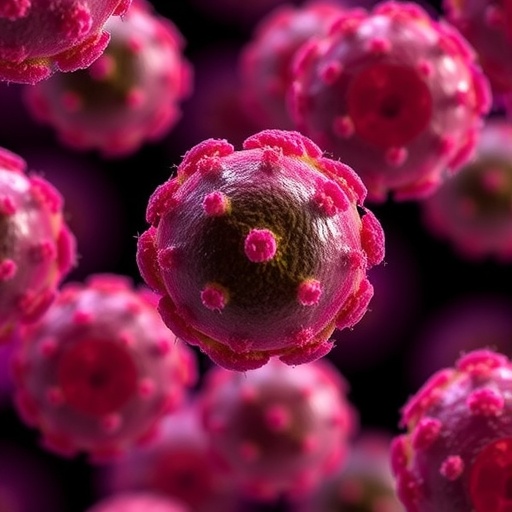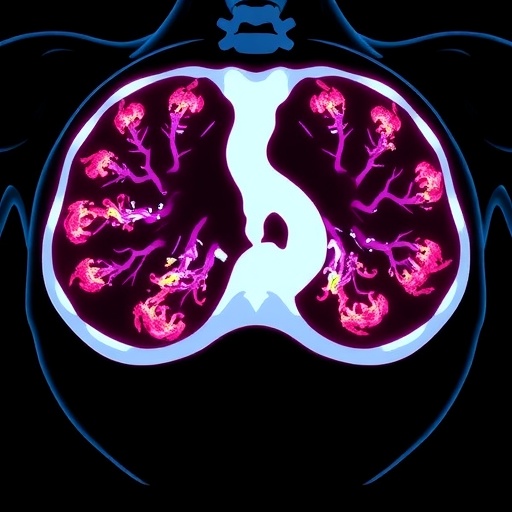In a groundbreaking advancement in ovarian cancer research, scientists have uncovered a critical mechanism by which high grade serous carcinoma (HGSC) — the deadliest and most prevalent form of ovarian cancer — evades immune destruction. The study, published in BMC Cancer, reveals that the cell surface protein podocalyxin (PODXL) plays a pivotal role in shielding cancer cell aggregates, termed spheroids, from infiltration and cytotoxic attack by natural killer (NK) cells. This discovery is poised to reshape the understanding of HGSC’s immune evasion strategies, potentially unveiling new therapeutic targets in a cancer subtype notorious for its poor prognosis and resistance to treatment.
High grade serous carcinoma accounts for the majority of ovarian cancer mortality due to its aggressive behavior and late-stage diagnosis. Despite advances in surgery and chemotherapy over the past three decades, survival rates have stagnated, largely because the tumor develops sophisticated mechanisms to bypass immune surveillance. Among these mechanisms, the formation of multicellular spheroids within the peritoneal cavity stands out — these dense clusters of cancer cells are chemoresistant and facilitate metastasis within the abdominal cavity. Yet, the molecular factors that promote spheroid resilience against immune cell attack have remained obscure until now.
Podocalyxin, a highly glycosylated sialomucin related to CD34, has previously been linked to poor outcomes in HGSC patients. It is expressed abundantly on the surface of aggressive tumor cells and is known to contribute to tumor cell adhesion, migration, and chemoresistance. The current study sought to investigate whether PODXL also mediates immune evasion by protecting cancer spheroids from destruction by NK cells, which are innate immune effectors capable of identifying and killing transformed or infected cells without prior sensitization.
To explore this, researchers utilized an in vitro co-culture system where spheroids derived from Kuramochi cells — an HGSC cell line exhibiting the highest endogenous levels of PODXL among tested lines — were grown in the presence of primary human NK cells isolated from peripheral blood mononuclear cells (PBMCs). They compared the infiltration and cytotoxic effects in spheroids formed by wild-type cells versus those engineered to lack PODXL through gene knockout techniques. This innovative experimental design allowed a direct assessment of PODXL’s role in modulating immune interactions within a physiologically relevant 3D cancer model.
Over a time course of 24, 48, and 72 hours, data showed that spheroids deficient in PODXL were significantly more susceptible to NK cell penetration and subsequent killing. In contrast, PODXL-expressing spheroids remained compact and largely impervious to NK cell infiltration, exhibiting higher proliferation rates despite immune challenge. These findings demonstrate that PODXL confers a physical and biochemical barrier to NK cells, effectively sanctifying the tumor spheroids from immune-mediated destruction.
Further validation came from studies with primary malignant spheroids isolated from the ascitic fluid of HGSC patients, which mirrored the cell line results. Spheroids with lower levels of PODXL showed increased NK cell infiltration and cytolysis, whereas those with high PODXL expression resisted immune attack. This translational aspect underscored the clinical relevance of PODXL as a marker of spheroid robustness and immune escape in the ovarian cancer microenvironment.
On a mechanistic level, PODXL’s dense sialylated glycocalyx likely impedes NK cell recognition and adhesion by masking activating ligands or by engaging inhibitory receptors on NK cells. Additionally, the compactness of PODXL-rich spheroids physically restricts immune cell penetration. This dual role positions PODXL as a master regulator of both molecular and structural defenses against innate immune effectors, enabling spheroid persistence in the hostile immune milieu of the peritoneal cavity.
The implications of these findings are vast. Targeting PODXL or its downstream pathways could disrupt spheroid integrity and enhance NK cell-mediated clearance, augmenting current immunotherapeutic approaches that have so far had limited success in ovarian cancer. Therapeutic antibodies, small molecules, or genetic strategies aimed at PODXL might restore immune surveillance and sensitize tumors to chemotherapy by dismantling these resistant spheroid architectures.
Moreover, this discovery sheds light on the broader phenomenon of tumor immune evasion not merely through adaptive immune suppression but via physical barriers erected by tumor cells themselves. In the context of HGSC, where metastatic spread within the peritoneum relies heavily on spheroid formation, elucidating the role of PODXL opens new avenues for research into the tumor microenvironment, metastatic processes, and host-tumor immune interactions.
Ongoing and future studies will be critical to decipher the full spectrum of PODXL’s interactions with immune cells and the molecular signaling networks involved. In particular, exploring how PODXL expression is regulated in response to microenvironmental cues and therapy resistance will provide further insights into its role as an oncogenic facilitator and immune modulator.
This research represents a significant leap forward in understanding the cellular armor that cancer employs to evade innate immunity. As NK cells are central to the first line of defense against malignancies, unraveling mechanisms such as PODXL-mediated protection is key to harnessing their full therapeutic potential. The findings by Tran et al. offer hope that strategies disrupting this protective barrier can improve outcomes for patients afflicted with high grade serous ovarian cancer — a disease that desperately needs innovative interventions.
In summary, the study reveals a novel immune evasion mechanism in HGSC whereby podocalyxin expression in tumor spheroids curtails NK cell infiltration and cytotoxicity. These data not only clarify a long-standing question regarding spheroid resilience but also identify PODXL as a promising target for therapeutic development. With the potential to enhance immune-mediated tumor clearance, these insights mark an exciting frontier in ovarian cancer biology and treatment innovation.
The dynamic interplay between tumor cells and immune cells continues to be a fertile ground for discovery, and podocalyxin’s role adds a new dimension to this complex relationship. As the field progresses, integrating such molecular insights with clinical practice could revolutionize the management of aggressive cancers characterized by immune escape and treatment resistance.
Tran and colleagues’ meticulous work underscores the necessity of multidisciplinary approaches combining cellular biology, immunology, and clinical oncology to confront the challenges posed by metastatic ovarian cancer. Their findings provide a foundation for future translational studies aimed at disrupting tumor defenses and reinvigorating the innate immune system’s capacity to combat cancer.
Subject of Research: High grade serous ovarian cancer and the role of podocalyxin in mediating immune evasion from NK cell infiltration.
Article Title: Podocalyxin protects high grade serous ovarian cancer spheroids from NK cell infiltration and spheroid destruction.
Article References:
Tran, N.L., Wang, Y., Quinn, K.M. et al. Podocalyxin protects high grade serous ovarian cancer spheroids from NK cell infiltration and spheroid destruction. BMC Cancer 25, 1674 (2025). https://doi.org/10.1186/s12885-025-15108-6
Image Credits: Scienmag.com
DOI: https://doi.org/10.1186/s12885-025-15108-6
Keywords: High grade serous carcinoma, podocalyxin, ovarian cancer, spheroids, immune evasion, natural killer cells, NK cell cytotoxicity, tumor microenvironment, cancer spheroids, chemoresistance, immune infiltration, tumor immune escape, peritoneal metastasis, glycoproteins, innate immunity
Tags: advancements in ovarian cancer researchcancer cell aggregates and metastasischemoresistance in ovarian cancerhigh grade serous carcinoma characteristicsimmune evasion strategies in HGSCmolecular mechanisms of immune evasionnatural killer cells and cancer resistanceovarian cancer spheroids and immune responseperitoneal cavity and tumor behaviorpodocalyxin role in ovarian cancersurvival rates in ovarian cancer treatmenttherapeutic targets for ovarian cancer





